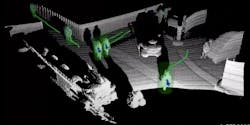Editor’s note: The following article is the second in a two-part series from SecurityInfoWatch.com (SIW) contributor Steve Surfaro examining security-related tech on display during this year’s all-virtual CES tradeshow. You read Part 1 here.
Gas NanoSensors
Last year, we reported that AerNos Inc. of San Diego, Calif., was named as the winner of a CES Innovation Award for nano sensors to detect harmful gases like methane. These came in a stationary form factor for smart city environment safety and on drones for critical mobile sensing of carcinogens at utilities and refineries. These sensors can also provide for early warning of wildfires in many use cases as well as safety monitoring of firefighter first responders.
This year’s CES Innovation Award brings air quality measurement home, processing data from environmental nano gas sensors through an artificial intelligence (AI) software app and delivering an air quality diagnosis.
AerHome detects toxic gases and micro-dust (particulate matter) to warn of hazardous exposure. The AerHome app can activate repeating exposure announcements from smart speakers or mobile devices. Messages can be critical, such as “warning, carbon monoxide detected,” or as a preventative maintenance reminder, like “air conditioning filter change.”
Smart and Zero Net Carbon Homes & Buildings
During the “Building Trust in Your Smart Home” session, Michael Mahan, Vice President - North America for Home & Distribution at Schneider Electric had insight that was also shared by other panelists, including Michelle Guss, Director, Residential Business Development at Crestron Electronics. “Five years ago you had a smart home to turn your lights and off. Today the home should anticipate your use and make decisions in the background including air quality, energy and water usage,” Guass said.
Additionally, during the “Healthy Buildings, Healthy Lives” session, Jordan Sun, Chief Innovation Officer for the City of San Jose, Calif., outlined “Better Buildings” and “Zero Net Carbon” as two technology-driven energy conservation program opportunities for solution provider and building owners/tenants. However, the trend with the most growth involves water conservation. “How can I incentivize IoT networks to avoid unnecessary water usage? No one wants to be stuck with a $900 water bill at the time your state is facing a freshwater crisis,” Sun said.
Schneider Electric introduced The Square D Energy Center at CES 2021 by integrating a smart thermostat, a smart meter, a back-up generator, and a solar inverter with an AI-driven energy management system. Home energy loads are classified as critical and normal loads. If an outage is caused by adverse weather, for example, the panel switches to ‘critical load’ mode. At this point, it decides if appliances like the refrigerator are ‘essential,’ then the energy supply is switched to these appliances only. With digital control from a single app, the power source can be changed to ensure resiliency and to reduce costs. The Square D Energy Center panel can monitor solar energy usage and track against the costs of utility power to optimize energy sourcing to reduce costs. For example, electric vehicles are high load and expensive to charge if you need to do so at peak time. The Square D Energy Center panel can help to manage these costs by identifying the best time of day to charge your vehicle or switch to solar for charging to avoid higher energy rates.
Smart Locks
August Home
The August Wi-Fi Smart Lock is attached to an existing deadbolt on the protected door side (inside), so existing physical key can still work. Install a DoorSense sensor and connect the lock to a Wi-Fi network (802.11 b/g/n 2.4 GHz), run the August App for iOS or Android and the Activity Feed will indicate door status.
Lockly
Although technically not introduced at CES 2021, the Lockly Vision is included here as a comprehensive fit for Airbnb hosts. Features include unlocking via fingerprint or via PIN code, entered either through the smartphone application or via time-sensitive temporary key code.
The Lockly Duo includes a keypad and a fingerprint reader, with a lever below and both built-in deadbolt and door latch.The Lockly Guard is made for sliding and swing-style French doors. At 1.73 inches wide and 11.9 inches tall, it fits most doors with thin frames. As with other Lockly products, number pad, fingerprint reader and control via Lockly App are included. All smartphone app usage requires a Wi-Fi network, unless otherwise specified. The optional Lockly Secure Link Wi-Fi Hub provides Alexa and Google support. You can read our full CES profile story on Lockly here.
Anker Innovations
The Eufy Smart Lock by Anker Innovations, which received a CES 2021 Innovation Award, features several different ways to unlock: 3D fingerprint recognition, built-in Wi-Fi for remote control, Bluetooth, and digital push buttons. It also features a one-year battery life and IP65 weatherproofing. The smart lock can unlock within just 1.3 seconds with a single touch of a finger.
LiDAR
At CES 2021, LiDAR seemed to be in every vertical. The LiDAR User eXperience (LUX) shower system, for example, controls temperature or water pressure by hand movement and Samsung’s Jet Bot vacuum cleaner has LiDAR and object recognition to avoid obstacles.
Israeli self-driving car developer Mobileye, in a partnership with its parent company Intel, announced they are developing a lidar system-on-a-chip (SoC) for use in different verticals and autonomous vehicles by 2025. By using Intel's own silicon fabrication tech, both active and passive lidar elements will be on a single chip and can add 3D object recognition to virtually any sensor with minimized impact on size.
The equally small SOSLAB’s solid-state LiDAR ‘ML’ won the Innovation Award in the Vehicle Intelligence & Transportation category with its modular optics and size, which is smaller than a iPhone 12.
Thermal Imaging
Just prior to CES 2021, Teledyne announced the acquisition of imaging specialist FLIR. Teledyne’s capabilities in X-rays, ultraviolet, microwave and radio will leverage FLIR filling a gap in the Teledyne portfolio, especially when it comes to low-cost thermal detectors. FLIR specializes in long wavelength infrared (LWIR) and their $1.9 billion sales revenue of digital imaging products will now be Teledyne’s largest segment to generate sales.
FLIR was founded in 1978 with airborne IR systems and diversified into the autonomous vehicle market in 2005 by supplying BMW with imaging technology for their 5, 6 and 7 Series luxury models. Although automotive is only a small portion of FLIR’s business, safety, object recognition and AI solutions are leveraged in their safety and security verticals.
CES 2021 as a Digital Event could not have come at a better time for security resellers to expand into monitoring of critical resources like water, environmental safety through early detection and traffic safety as cities begin transitioning to autonomous vehicles for congestion reduction. As practitioners in San Jose, Calif., have discovered, early detection of critical resource loss like water are a sound investment and provide a unique opportunity for security solution providers to diversify their business.
About the Author:
Steve Surfaro is Chairman of the Public Safety Working Group for the Security Industry Association (SIA) and has more than 30 years of security industry experience. He is a subject matter expert in smart cities and buildings, cybersecurity, forensic video, data science, command center design and first responder technologies. Follow him on Twitter, @stevesurf.
About the Author

Steve Surfaro
Steve Surfaro
Steve Surfaro is Chairman of the Public Safety Working Group for the Security Industry Association (SIA) and has more than 30 years of security industry experience. He is a subject matter expert in smart cities and buildings, cybersecurity, forensic video, data science, command center design and first responder technologies. Follow him on Twitter, @stevesurf.
